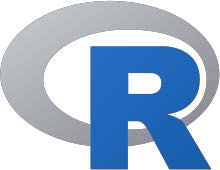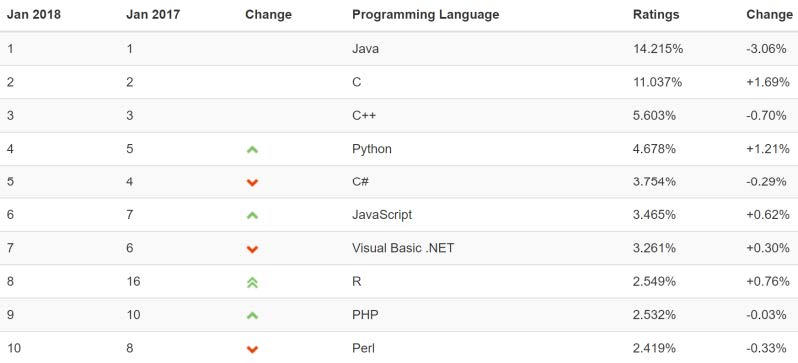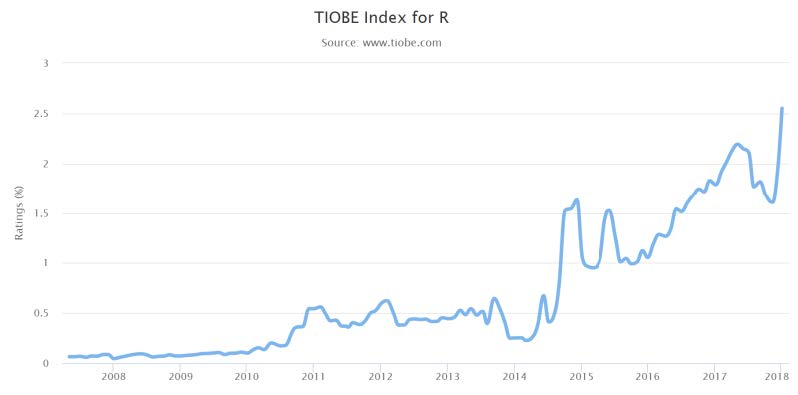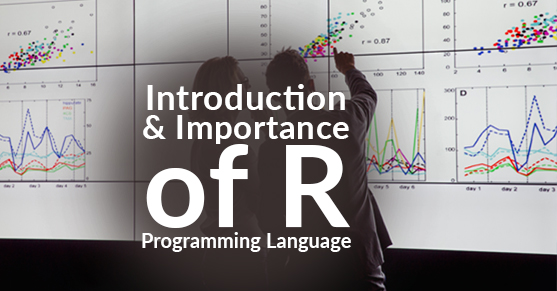
Introduction
R is an open source programming language. It was developed by Roass Ihaka and Robert Gentleman in August 1993. And they decided the name for this language with their name’s first letter. Hence the name for this is R-Programming language, and the stable version was released in December 2018.
It has been developed for statistical computing and graphics supported by R Foundation. The R language is widely used among statisticians and data miners for statistical software and data analysis Polls, data mining surveys. As of Feb 2019, R ranks 15th in TIOBE (The Importance of Being Earnest) index.
Importance of R Programming Language
- R is a well-developed, simple and effective programming language. Which includes conditional loops; user defined recursive functions and input and output facilities.
- R provides graphical facilities for data analysis and display.
- R is a very flexible language. It does not necessitate that everything should be done in R itself. It allows the use of other tools, like C and C++ if required.
- R has an effective data handling and storage facility.
- R provides an extensive, coherent and integrated collection of tools for data analysis.
- R also includes a package system that allows the users to add their individual functionality in a manner that is indistinguishable from the core of R.
- R is actively used for statistical computing and design. It has brought about revolutionary improvements in big data and data analytics. It is the most widely used language in the world of data science! Some of the big shots in the industry like Google, LinkedIn, and Facebook, rely on R for many of their operations.
The Impressive Growth of R Programming Language
R jumps to 8th position in TIOBE language rankings
The R language surged to 8th place in the 2017 TIOBE language rankings, up 8 spots from a year before.


R Ecosystem
Igraph
Igraph is an open source network analysis tool made by Gábor Csárdi. The software ships with a wide variety of network analysis methods, and it can be used in R, C, C++, and Python as well.
Extension Packages and CRAN
The vast array of add-on packages that extend the functionality of the R language are one of the biggest draws for new users. The R Project has several groups working within it, one of which is the ‘CRAN Repository Maintainers,’ who run CRAN – or the “Comprehensive R Archive Network.” CRAN is the place where R users go to obtain these additional packages.
RStudio
RStudio is a free and open-source integrated development environment (IDE) for R, a programming language for statistical computing and graphics. RStudio was founded by JJ Allaire, [5] creator of the programming language ColdFusion. Hadley Wickham is the Chief Scientist at RStudio.[6]
RStudio is available in two editions: RStudio Desktop, where the program is run locally as a regular desktop application; and RStudio Server, which allows accessing RStudio using a web browser while it is running on a remote Linux server. Prepackaged distributions of RStudio Desktop are available for Windows, mac OS, and Linux.
Sample R Programming Language Script

R Hadoop a perfect match
R programming language is the preferred choice amongst data analysts and data scientists because of its rich ecosystem catering to the essential ingredients of a big data project-data preparation, analysis, and correlation tasks.
R and Hadoop were not natural friends but with the advent of new packages like Rhadoop, RHIVE, and RHIPE – the two seemingly different technologies, complement each other for big data analytics and visualization. Hadoop is the go-to big data technology for storing large quantities of data at economical costs, and R programming language is the go-to data science toolfor statistical data analysis and visualization. R and Hadoop combined prove to be an excellent data crunching tool for some seriously big data analytics for business.
R with Relational Database Management Systems (RDBMSs)
One of the strongest selling points of R is, that unlike other statistical packages it can import data from numerous sources and almost unlimited data formats. As the Big Data is often stored, not as separate files, but in the form of tables in RDBMSs, R can easily connect to a variety of traditional databases and perform basic data processing operations remotely on the server through SQL queries without explicitly importing large amounts of data to the R environment.
SQLite database run locally on a single machine, a MariaDB database deployed on a virtual machine, and a PostgreSQL database hosted through the Amazon Relational Database Service (RDS)-a highly-scalable Amazon Web Services solution for relational databases. These examples provide practical evidence of the suitability of SQL databases for Big Data analytics using the R language. SQL databases can be easily implemented in data processing workflows with R as great data storage containers or for essential data cleaning and manipulations at early stages of the data product cycle. This functionality is possible due to well-maintained and widely used third-party packages such as dplyr, DBI, RPostgres, RMySQL, and RSQLite, which support R’s connectivity with a large number of open-source SQL databases.
Spark with R
Spark connects well with the R language through its SparkR package. Analysts can create Spark RDDs directly from R using many data sources, from individual data files in CSV or TXT format to data stored in databases or HDFS.
As the SparkR package comes pre-installed with Spark distributions, R users can quickly transfer their data processing tasks to Spark without any additional configuration stages.
Smart Data
Smart data encapsulates the predictive or even prescriptive power of statistical methods and machine learning techniques available to data analysts and researchers. Currently, R is positioned as one of the leading tools on the market in terms of the variety of algorithms and statistical models it contains. Its recent integration with Big Data machine learning platforms like H2O and Spark MLlib, as well as its connectivity with the Microsoft Azure ML service, puts the R language at the very forefront in the ecosystem of tools designed for Big Data predictive analytics. In particular, R’s interface with H2O offered by the h2o package already provides a very powerful engine for distributed and highly-scalable classification, clustering, and Neural Networks algorithms that perform exceptionally well with a minimum configuration required from users.
Conclusion
R ecosystem is changing and seeing that it’s been a part of the rapid expansion of the data science field. In general, the number of users of a language isn’t directly related to its popularity. But the large and fast-growing community around the R language has undoubtedly contributed to its value as a programming language and as a data analysis environment.
Within the next several years we may expect many new machine learning start-ups to be created which will aim at robust connectivity with R and other open-source analytical and Big Data tools. This is an exciting area of research and hopefully, the coming years will shape and strengthen the position of the R language in this field.

